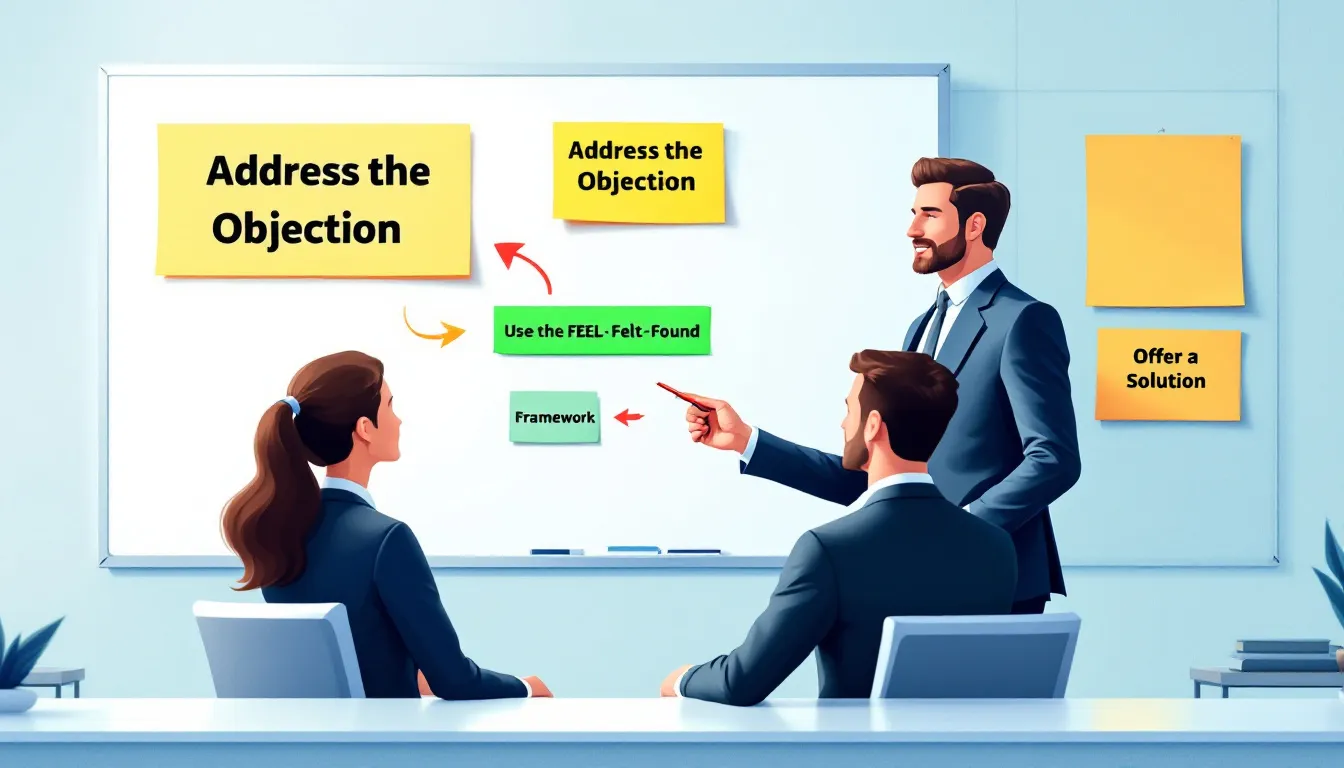Selling anything to anybody is within your reach. This guide provides practical tips on how to sell anything to anybody, understand your audience, build trust, and close deals. You’ll get clear, actionable steps to enhance your sales skills.
Key Takeaways
- Understanding your target audience and creating detailed buyer personas are critical for tailoring effective sales strategies.
- Building trust through genuine relationships and active listening enhances client loyalty and fosters successful sales interactions.
- Mastering persuasive techniques and knowing how to effectively close sales boosts your confidence and significantly increases conversion rates.
To Sell Anything You Must Understand Your Target Audience

The foundation of successful selling lies in understanding your target audience. It’s not just about knowing who your potential customers are but also gaining insights into their needs, preferences, and pain points. When you truly understand your target market, you can tailor your sales pitch to resonate with them, making your product or service irresistible. Dedicating time to learn about your target customers sets the stage for effective communication and meaningful connections.
Refining your selling strategies involves continuously learning about your target customers over time. This involves:
- Analyzing commonalities among your customer base, such as popular products and buying behaviors.
- Utilizing modern tools like social media to assist in researching potential customers and gathering valuable insights.
- Understanding your buyers through research to improve communication and increase sales.
Creating Detailed Buyer Personas
Creating detailed buyer personas is a crucial step in understanding your target customers. A buyer persona is a fictional character sketch of your ideal customer, based on real demographic and psychographic data. By identifying the specific needs, wants, lifestyle, motivations, and perspectives of your potential buyers, you can create targeted marketing efforts that resonate on a deeper level.
Crafting accurate buyer personas involves analyzing both demographics and psychographics. Use real customer data to enhance the accuracy of your personas and refine your marketing strategies. This detailed understanding of your prospective buyers will help you attract increased website traffic and potential customers, ultimately leading to more effective sales efforts.
Leveraging Customer Data for Insights
Gaining insights into your target customers’ preferences and behaviors relies on leveraging customer data. Customer feedback and analytics can reveal essential information that helps tailor your sales approach. Surveys, web forms, and social media tools are effective methods for gathering data on consumer motivations and preferences, aiding in product development and marketing strategies to gain insights.
Tools like Mailchimp’s audience dashboard can help gather insights about potential customers, providing at-a-glance data on website usage and email campaign clicks. Understanding core motivators behind customer purchases, like safety, security, growth, and social payoff, allows you to better align your sales interactions with what truly matters to your prospects.
To Sell Anything You Must Build Trust and Relationships

Trust and relationship-building are fundamental to successful selling. People won’t buy from you if they don’t trust you, so it’s crucial to create a sense of trust in your client relationships. This involves adding value rather than merely pushing products, focusing on how your product helps in real-life scenarios. Tailoring your communication to the specific needs and preferences of your potential customers increases the likelihood of engagement and building relationships.
Social media can facilitate genuine connections through two-way conversations with potential buyers, helping to build trust and rapport. Transparency is also crucial in communication; avoiding exaggerations or false promises helps maintain credibility in content marketing.
Once you establish rapport, transitioning into delivering a winning sales pitch and asking for referrals becomes more natural and effective.
Techniques for Building Rapport
Active listening is a cornerstone of building rapport in sales. Listen carefully to your prospect’s personality, making them feel valued and fostering loyalty as a sales rep.
Here are some strategies to enhance your active listening skills:
- Ask open-ended questions to encourage dialogue.
- Uncover deeper insights into the customer’s issues.
- Demonstrate genuine interest in their responses.
- Practice effective communication throughout the conversation.
This approach not only helps you understand their needs but also builds trust and strengthens your relationship with the customer, fostering a deep understanding of their preferences.
Connecting with clients on a personal level can be achieved by sharing personal stories or humor to find common interests in your professional life. Showing value in the conversation and focusing on their concerns builds a strong foundation for a lasting relationship.
Establishing Authority and Credibility
Establishing authority and credibility is essential for building trust with your customers. Demonstrating a solid understanding of industry trends and showcasing your expertise helps relate to customer challenges. Acting as a reliable consultant and sharing testimonials and case studies can effectively establish your credibility.
Using referrals as a form of social proof can further enhance your authority in the eyes of potential buyers. Highlighting customer testimonials during your sales pitch can showcase your success in the field and build trust with your prospects.
To Sell Anything You Must Master the Art of Persuasion
Mastering the art of persuasion is key to becoming a successful salesperson. Emotions play a significant role in purchasing decisions, influencing buyer behaviors more than rational arguments. Leveraging psychological triggers like scarcity, social proof, and the anchoring effect can enhance your sales effectiveness across various products and industries.
Effective persuasion involves making both rational and emotional appeals to buyers. Continuously testing what works and improving your sales approach based on results refines your selling strategies and achieves better outcomes.
Understanding Psychological Triggers
Understanding psychological triggers is essential for influencing buyer decisions. Scarcity creates a sense of urgency, prompting quicker purchasing decisions. Social proof influences buyers by showcasing how others have benefited from a product, making it more relatable and trustworthy. The anchoring effect suggests that the first price seen influences the perception of the value of subsequent prices.
Effective sales pitches often emphasize emotional benefits over technical features, resonating more with potential buyers. Using vivid customer stories with personal details as much detail can create a simple yet effective emotional impact on potential customers through creative ideas, as many salespeople know, including real life examples. A good salesperson understands the importance of this approach.
Crafting a Compelling Sales Pitch
Crafting a compelling sales pitch involves highlighting the biggest customer benefits first to attract attention. Clearly explain the value the customer will see if they buy your product and address each need and pain point of the potential customer. Use ‘you’ language to keep the focus on the buyer and demonstrate understanding to sell anything to anyone.
Personalize your call-to-action text, which can lead to a significantly better conversion rate than generic CTAs. Avoid overly scripted language and create memorable moments by recapping the value propositions during the pitch.
To Sell Anything You Must Qualify Your Leads Effectively
Qualifying leads effectively can greatly enhance your conversion rates. Structured lead qualification methods can improve business conversion rates by up to 68%. The first step in assessing a lead’s readiness to buy is understanding their budget.
Lead nurturing involves actions that move leads toward purchasing over time. By applying structured methods like the BANT framework, you can prioritize your sales efforts and focus on leads that are more likely to convert.
Using the BANT Framework
The BANT framework, which stands for:
- Budget
- Authority
- Need
- Timing
is utilized by many successful B2B companies as a primary tool for lead qualification. Assess each lead against these critical factors to prioritize your sales efforts and improve conversion rates.
By focusing on Budget, you ensure that the lead has the financial capacity to purchase. Authority involves identifying if the lead has the decision-making power. Need assesses if your product solves a problem for the lead, and Timing determines if the lead is ready to buy now.
Identifying Decision-Makers
Identifying decision-makers in business sales is crucial for tailoring your approach and engaging the right person in the purchasing process. Understanding who holds the authority to make purchasing decisions allows you to focus your efforts on convincing the right individuals.
Engaging the right decision-makers involves using effective communication techniques to present your value proposition compellingly. This ensures that your sales interactions are productive and lead to informed decisions.
To Sell Anything You Must Overcome Objections Smoothly

Overcoming objections smoothly is a vital skill in the sales process. Listening to the customer’s objections helps you understand their concerns better and prepare appropriate responses. Leverage the client’s hesitation to guide them towards making a decision and highlight the potential drawbacks of not making a decision.
Presenting a limited range of offerings can combat choice overload and make the decision easier for the prospect. Preparing responses to common objections in advance helps you avoid appearing unsure and maintains confidence during sales interactions, which can ultimately save time.
Common Sales Objections and Responses
Common sales objections include price, need, and urgency. It’s crucial to prepare responses in advance for these recurring objections to handle them effectively. Clare Jones, for instance, addressed a customer’s budget concerns by presenting the neon sign as an investment rather than an expense, helping the customer see how it could lead to more money.
Framing objections positively and providing clear, concise responses alleviates potential buyers’ concerns and moves you closer to closing the sale.
Active Listening and Acknowledgment
Active listening not only aids in retaining information but also demonstrates that you genuinely care about the customer’s concerns. After acknowledging an objection, ask questions to understand the value concern and provide a tailored response to answer questions.
Taking notes while listening can help if you’d like to work with a client again, ensuring that you remember their specific needs and preferences. This approach fosters trust and enhances the overall sales experience.
To Sell Anything You Must Close the Sale with Confidence
Closing a sale with confidence is the final step in the sales process and can make or break your efforts. A smooth closing should feel like the next logical step in the conversation. Formally requesting the prospect’s agreement to proceed with the purchase, while maintaining a confident and positive demeanor, ensures a high probability of success.
Effective closing involves understanding the prospect’s readiness and addressing any lingering doubts. Applying proven closing techniques and creating a sense of urgency nudges potential buyers towards making a decision, thereby boosting your sales efforts and achieving more sales.
Effective Closing Techniques
The assumptive closing technique operates on the belief that the prospect is ready to buy, prompting the seller to ask how many units they want instead of if they want to buy. Including a clear and strong call-to-action can significantly increase response rates and lead to successful conversions.
Other effective selling techniques include the direct close, where the seller directly asks for the sale, and the scale close, which gauges interest levels by asking prospects to rate their interest on a scale. These methods, when used appropriately, can significantly impact your sales skills success and help you sell effectively.
Creating a Sense of Urgency
Creating a sense of urgency in sales encourages immediate action and can significantly boost conversion rates. The scarcity close uses limited-time offers to create urgency, motivating prospects through the fear of missing out (FOMO). Highlighting the consequences of not making a decision, such as missing out on a discount or limited stock, can further enhance the urgency and influence customer behavior, especially in time selling.
This approach leverages psychological triggers to prompt quicker decisions and drive more sales.
Follow Up and Nurture Relationships
Following up and nurturing relationships is crucial for building customer loyalty and increasing future new sales. 93% of customers are likely to repeat purchases from businesses with excellent customer service. Engaging with customers after a sale can lead to increased loyalty, referrals, and repeat purchases.
Post-sale follow-up should be personalized and reflect the customer’s shoes specific experience and preferences. This strengthens the relationship and enhances their overall experience, leading to more sales and a loyal customer base.
Implementing Follow-Up Strategies
Personalized follow-up communications evoke stronger connections with customers, making them feel valued and appreciated. Craft follow-up messages that reflect the customer’s specific experience and preferences to enhance their engagement and loyalty.
Effective follow-up strategies include sending thank-you notes, checking in on their satisfaction with the product, and offering additional value through articles or thoughtful questions. These actions demonstrate genuine interest and help maintain a positive relationship with your customers.
Encouraging Referrals and Testimonials
Satisfied customers can be powerful advocates for your business, helping to attract new customers through their referrals and testimonials. Encourage your existing customers to share their positive experiences, creating a ripple effect that motivates others to consider your customer’s products or services.
Implement strategies such as follow-up communication and providing incentives to encourage your customers to provide referrals and testimonials. This approach leverages social proof to build credibility and attract more customers to your business.
Selling Online: Best Practices For Selling Anything

Selling online presents unique challenges and opportunities. Essential factors for selling products online effectively include ease of finding, trust, and buying product. High-quality product photos are crucial since they are typically the first thing customers notice when products are sold in an online marketplace.
AI analyzes customer data and predicts buying patterns, enhancing personalization in outreach. Email campaigns and social media are effective marketing strategies that can help improve sales numbers for online stores. Utilizing customer relationship management software can streamline the follow-up process with automated workflows, ensuring a consistent and personalized customer experience.
Choosing the Right Selling Platform
Choosing the right selling platform is essential for reaching your target customers and achieving sales success. Selling digital products requires a specialist platform, while most general-purpose ecommerce platforms are suitable for physical products. The choice of platform should reflect both the nature of the products and the characteristics of the target customer base.
Examples of platforms for B2C companies include Amazon, Shopify, and Etsy, each catering to different business sizes and customer needs. Matching the business size and customer needs when choosing selling platforms ensures that you can effectively reach your target audience and meet their expectations.
Optimizing Your Online Store
Optimizing your online store is crucial for attracting and engaging potential customers. An effective online store should focus on providing a fast and intuitive navigation experience for potential buyers. This creates a welcoming environment that attracts target customers and encourages them to explore your offerings.
A well-optimized online store combines user-friendly features and visual appeal to improve customer engagement and drive more sales. Ensuring that your online store includes all the features that are visually appealing and easy to navigate can make a significant difference in your online sales success.
Utilizing Email Marketing
Email marketing is a powerful tool for reaching your target customers and driving online sales. Segmenting your email list allows for targeted marketing efforts that cater to the specific interests and needs of different customer groups. Mailchimp helps refine these efforts by identifying who clicked through email campaigns, providing valuable insights for future campaigns.
The average open rate for retargeting emails is 41%, indicating strong engagement with personalized content. By utilizing email marketing effectively, you can maintain consistent communication with your customers and encourage repeat purchases, ultimately driving more sales for your online store.
To Sell Anything You Must Apply Everything

To Sell anything to anybody requires a deep understanding of your target audience, building trust and relationships, mastering persuasion, qualifying leads, overcoming objections, closing sales with confidence, nurturing relationships, and leveraging online selling best practices. Each step in the sales process is interconnected and vital for achieving sales success.
By applying the strategies and techniques discussed in this guide, you can transform your sales approach and achieve unparalleled success. Remember, sales is both an art and a science, requiring continuous learning and adaptation. Embrace the journey and watch your business thrive.
Frequently Asked Questions
Why is understanding my target audience important for sales success?
Understanding your target audience is crucial for sales success because it enables you to customize your approach to meet their unique needs and desires, making your offerings far more compelling. When you connect with your audience on this level, you greatly enhance your chance to sell anything!
How can I build trust with potential customers?
To build trust with potential customers, focus on adding value and being transparent in your communication. Show genuine interest in their needs and provide real-life examples of how your product can help them succeed!
What are some common psychological triggers that influence buying decisions?
Understanding psychological triggers like scarcity, social proof, and the anchoring effect can significantly impact your buying decisions. Harness these triggers to create urgency and trust, and watch how they transform your sales strategy. Soon you’ll be able to sell anything.
How can I effectively qualify leads to improve conversion rates?
To effectively qualify leads and boost conversion rates, implement the BANT framework to prioritize prospects based on their budget, authority, need, and timing. Focusing on the right leads will significantly enhance your chances of closing deals!
What are some best practices for selling products online?
To succeed in selling products online, focus on selecting the right platform, creating a user-friendly and visually appealing store, and leveraging email marketing for consistent customer engagement. By implementing these strategies, you can significantly boost your sales and build a loyal customer base.

